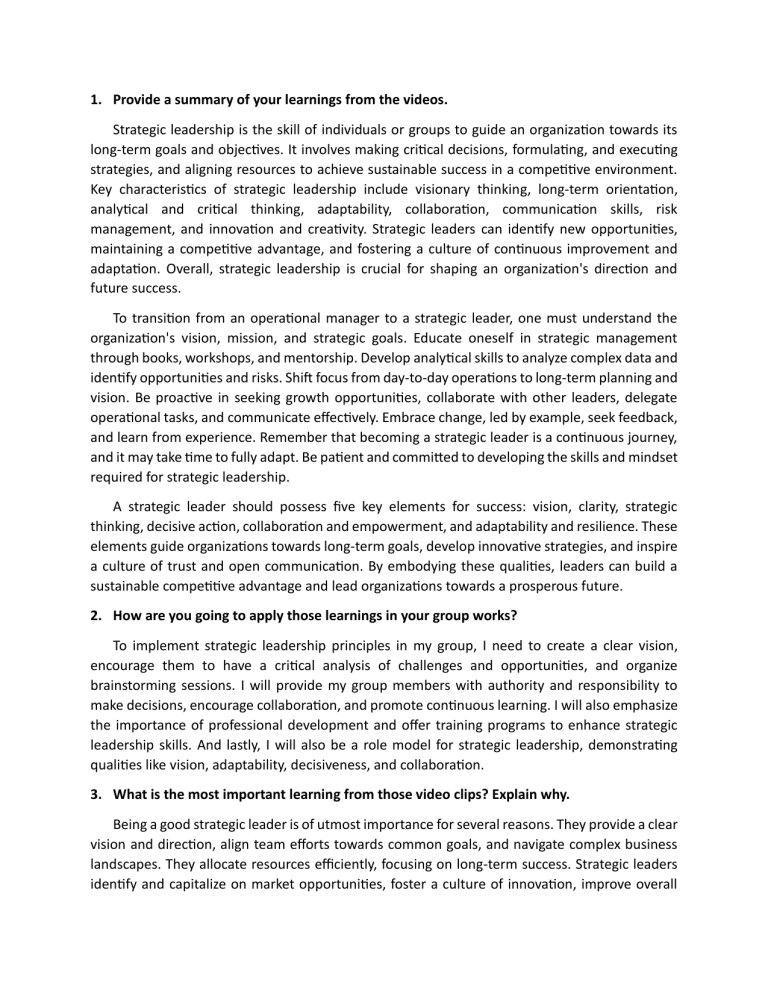
1. Provide a summary of your learnings from the videos. Strategic leadership is the skill of individuals or groups to guide an organization towards its long-term goals and objectives. It involves making critical decisions, formulating, and executing strategies, and aligning resources to achieve sustainable success in a competitive environment. Key characteristics of strategic leadership include visionary thinking, long-term orientation, analytical and critical thinking, adaptability, collaboration, communication skills, risk management, and innovation and creativity. Strategic leaders can identify new opportunities, maintaining a competitive advantage, and fostering a culture of continuous improvement and adaptation. Overall, strategic leadership is crucial for shaping an organization's direction and future success. To transition from an operational manager to a strategic leader, one must understand the organization's vision, mission, and strategic goals. Educate oneself in strategic management through books, workshops, and mentorship. Develop analytical skills to analyze complex data and identify opportunities and risks. Shift focus from day-to-day operations to long-term planning and vision. Be proactive in seeking growth opportunities, collaborate with other leaders, delegate operational tasks, and communicate effectively. Embrace change, led by example, seek feedback, and learn from experience. Remember that becoming a strategic leader is a continuous journey, and it may take time to fully adapt. Be patient and committed to developing the skills and mindset required for strategic leadership. A strategic leader should possess five key elements for success: vision, clarity, strategic thinking, decisive action, collaboration and empowerment, and adaptability and resilience. These elements guide organizations towards long-term goals, develop innovative strategies, and inspire a culture of trust and open communication. By embodying these qualities, leaders can build a sustainable competitive advantage and lead organizations towards a prosperous future. 2. How are you going to apply those learnings in your group works? To implement strategic leadership principles in my group, I need to create a clear vision, encourage them to have a critical analysis of challenges and opportunities, and organize brainstorming sessions. I will provide my group members with authority and responsibility to make decisions, encourage collaboration, and promote continuous learning. I will also emphasize the importance of professional development and offer training programs to enhance strategic leadership skills. And lastly, I will also be a role model for strategic leadership, demonstrating qualities like vision, adaptability, decisiveness, and collaboration. 3. What is the most important learning from those video clips? Explain why. Being a good strategic leader is of utmost importance for several reasons. They provide a clear vision and direction, align team efforts towards common goals, and navigate complex business landscapes. They allocate resources efficiently, focusing on long-term success. Strategic leaders identify and capitalize on market opportunities, foster a culture of innovation, improve overall performance, create, and sustain a competitive advantage, and adapt to changes in the business environment. They inspire and motivate team members, leading to higher morale, increased job satisfaction, and better retention of talented employees. Overall, strategic leadership is the driving force behind an organization's sustained success and growth.







